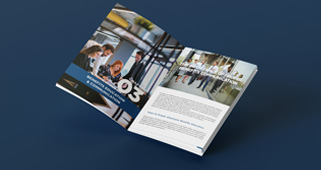Employee assistance programs, or “EAPs” are programs structured to assist employees in the resolution of a range of personal problems. EAPs serve employees chiefly in a mental health capacity, which is an important aspect of wellness.
With an effective EAP in place, employees can offload stressors and ultimately work through problems, so they can show up to work with a clear mind. EAPs can help an employee address issues like alcohol and substance abuse, the stress of child or eldercare. They can also assist employees through a divorce or other interpersonal changes, and even financial or legal problems.
Your EAP program doesn’t have to deliver services in-house; in fact, many do not. Often, EAPs utilize vendors or providers sourced through the company’s health plan and refer employees out to specialists when needed. Help for employees can be accessed in a provider office, or virtually, whether via phone, chat, or webcam appointments.
Similar to more traditional health and wellness programs, some EAP benefits can also be made available to an employee’s partners and/or dependents.
EAPs can look different from organization to organization. There are several different core EAP models, including the following:
- In-house, management sponsored EAPs, where EAP staff are employed by the company itself (popular for large companies)
- Fixed fee contract EAPs, where a vendor is used for services like counseling and referrals
- Fee for service contract EAPs, where employees use an EAP provider and pay when the EAP benefits are used
- Consortia EAPs, where a group of smaller businesses share EAP services, reducing costs
- Member or peer assistance programs, which are often sponsored or provided by unions.
How to Increase EAP Utilization:
Once you’ve created an EAP, getting the word out makes all the difference. Here are our top tips on increasing employee EAP utilization.
Raise Awareness for Your EAP Across Different Media Channels
Your employees may have heard that you have an EAP, and you might have included a blurb about the program during orientation. But just because your employees have heard about it once, or they’ve skimmed past it in the employee handbook, doesn’t necessarily mean they’ll think of EAP resourcees when they actually need them.
Consider whether you’re reaching employees where they are. For example, you could create a poster for your breakroom(s), send out an email on World Mental Health Day, or deliver brochures during one of the most stressful times of year for many – the holidays. Don’t be afraid to get creative and take a shot at multiple methods and channels to deliver your message.
Emphasize all the Items Your EAP Covers
Your employees may not be aware of all the benefits your EAP provides. There is a common misconception that employee assistance programs only (or chiefly) cover alcohol and substance abuse counseling. Consider whether it’s possible to highlight different benefits for different groups. If you have employee resource groups, for example, a human resources representative might reach out to resource groups individually during group meetings.
Remove the Stigma Associated with Mental Health Struggles
According to the American Psychiatric Association, 1 in 5 adults struggles with mental illness during their lifetime. Many individuals still view mental health struggles as personal flaws rather than medical issues. One of the best ways to remove the stigma surrounding reaching out for health can be through testimonials and success stories. Sometimes seeing that someone else went through a similar situation, used outside resources for help, and has come through the process successfully, is all it will take to encourage an employee to reach out.
Every Time Your Employees Hear about EAPs, Use the Word “Confidential.”
The Society for Human Resource Management reports that many workers do not use employee assistance programs out of fear that “the information discussed won’t be kept confidential.” When marketing the benefits of your EAP, make sure to always, always stress the complete confidentially required (and observed) by your EAP provider, vendor, or in-house staff. Stress that confidentiality is complete and total, and that nothing will be divulged to HR unless the employee is truly at risk of hurting themselves or others.
Should My Company Start an Employee Assistance Program?
EAPs are designed to benefit both employees and employers. If you’ve designed an effective program, you’re likely to see:
- increased job satisfaction
- reduced rates of absenteeism
- lower health care costs
- higher productivity
- improved employee retention.
According to the United States Department of Health and Human Services, EAPs have also been correlated with a 73 percent productivity increase for employees facing mental health issues, a 66 percent increase for employees facing physical health challenges, and a 62 percent decrease in tardiness and absences for employees who had EAP interventions.
The benefits to employers are clear. As the Society for Human Resources Management states, “EAPs are cost-effective tools to mitigate” a plethora of employee risks. It’s no surprise, then, that the provision of employee assistance programs is on the rise. The 2019 SHRM Employee Benefits research report found that 79 percent of surveyed employers offered an EAP. If you’re considering starting an EAP, you’re in good company.
Need a Hand Implementing or Revamping Your Employee Assistance Program?
From time to time, we can all use a little help from the experts. That’s where Benely comes in. As experts in employee benefits, wellness, and compliance, Benely knows that an effective employee assistance program can positively impact employee satisfaction, productivity, and an employer’s bottom line.
Benely is here to help revamp your company culture simply, seamlessly, and happily. Contact Benely or request a free demo today.






